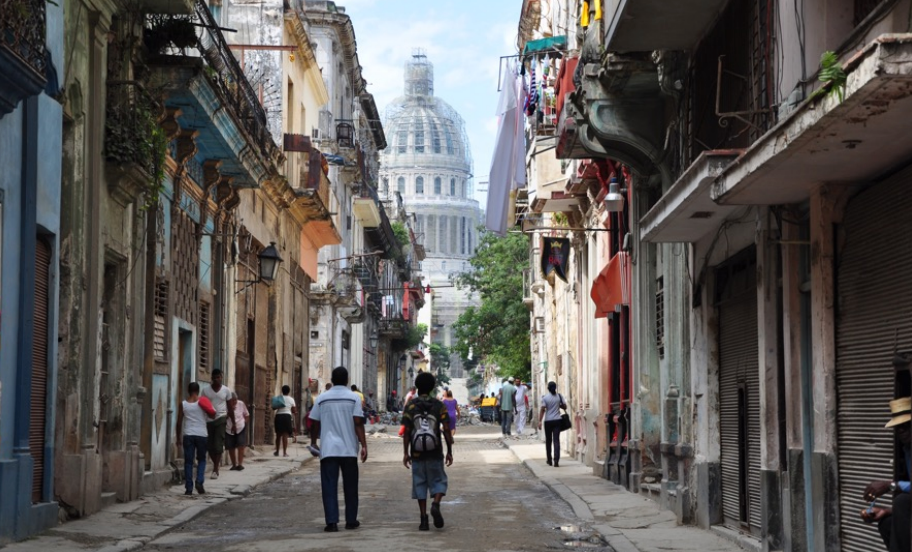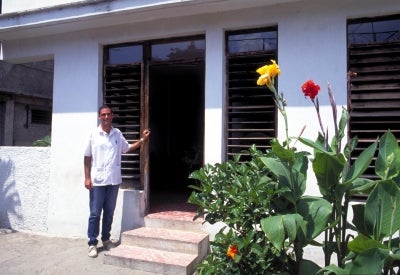Cuba

Key country characteristics
- Upper-middle income country where PHC services form the core of the health system
- Population: 11.3M
- GDP per capita: $9,099
- Life expectancy at birth: 79


Lauren Goodsmith/Courtesy of Photoshare
After the 1959 communist revolution, Cuba nationalized its health care system and made all heath services public1. In 1984, Cuba formally established three tiers of care: consultorios to provide primary care, polyclinicos to provide specialized secondary care, and institutos to provide highly specialized tertiary care1. Primary care services form the core of the Cuban health system, and more than 80 percent of health visits take place with primary care providers in consultorios22.
The Cuban health care system relies heavily on primary care providers—both physicians and nurses. In order to ensure a sufficient trained health workforce to provide comprehensive primary care, Cuba developed a robust, free medical education program. In 2013, Cuba trained more than 10,000 physicians and approximately 30,000 total clinicians4. As a result, Cuba has 6.7 physicians and 8.2 nurses for every 1000 people2. By comparison, the United States has 2.8 physicians for every 1000 people2. Indeed, Cuba trains so many physicians that every year they export more than 30,000 physicians to countries in need across Latin America and Africa3. To bolster the primary care system, Cuba requires that all graduates of medical school first complete family medicine training before they can specialize. Ultimately, 70 percent of physicians remain in family medicine as primary care providers (PCPs), compared to only 10 percent in the United States33.
In addition to its strong workforce, primary health care in Cuba is facilitated by a system of “geographic empanelment,” the process of assigning patients to a primary care team using fixed geographic areas to delineate patient grouping. Each consultorio is staffed by a PCP, a nurse and a medical assistant who together are responsible for the health of 600-700 patients, or approximately 150 families26. Providers are encouraged to view their populations as cohesive groups rather than unrelated individuals, for instance, by organizing medical records by family8. Within the primary health care practice, there is a strong focus on the prevention of illness and disease and the primary care team is expected to conduct active surveillance and risk identification within their empanelled population78. Explicit risk stratification categories are used to assess each patient in the panel and physicians must report the number of patients in each risk category to the local health district5.
Each PCP typically spends half of their time conducting home visits, which allows them to closely monitor patients identified as high-risk and identify health concerns before they advance6. All Cubans receive at least two home visits per year, and patients identified as high-risk can be seen as often as two times per week5. In addition to improving the continuity of care for patients with chronic conditions, home visits facilitate conversations between PCPs and family members about how to best address the patient’s health and well-being5.
Primary care in Cuba is structured so that physicians can consider the health needs of the whole community.
PCPs live in the communities they serve and consultorios are generally attached to or are near the homes of PCPs2. This continuous community presence increases community trust in the primary care teams."
Additionally, primary care teams conduct specific activities to further strengthen their ties to the communities they serve. At the end of every year, consultorios conduct a public health situation analysis to review the past year’s performance, determine issues to be addressed, and plan ways to promote wellbeing and to tackle community health issues in the year to come. Community members are encouraged to attend and participate in the decision-making process6.
In Cuba, secondary care services are provided at multidisciplinary polyclinicos, each of which serves the population of 30-40 consultorios2. To improve the continuity and coordination of care for patients, guidelines are set to promote the formation of strong relationships between primary care physicians and specialist physicians working in polyclinicos. Dual referral systems allow patients to be transferred smoothly from primary to secondary care and from secondary care back to their PCP. Additionally, PCPs often accompany their patients in person to the polyclinico and/or have specialists come directly to the consultorio to perform consultations6. In the event that a patient is admitted to the polyclinico, PCPs either accompany the patient to the hospital or are personally briefed by the emergency department physician7.
The improvement in health indicators in Cuba over the past four decades has been rapid:
Beyond primary care, however, Cuba’s health system is challenged by international trade restrictions. Often, equipment, training, and medications needed for providing high-level tertiary care are lacking and there are concerns about the accuracy of the data reported by the Cuban government. Nonetheless, clear progress in achieving health outcome targets in Cuba has been made through a strong PHC system.